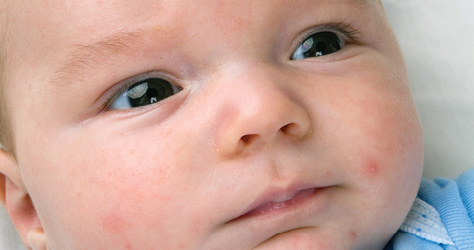From cradle cap to acne, most baby skin problems will disappear without treatment. Here are some tips to prevent and soothe common skin conditions.
Whilst most baby skin conditions will clear up over time, if you are unsure or concerned about any markings you notice on your baby’s skin, seek medical advice so that you can be reassured.
At a glance
- Rashes are common, especially in the first year
- Cradle cap will usually disappear on its own
- Whilst eczema is inherited, certain allergens can irritate it

Rashes
Rashes are common, particularly in the first year. It is best to seek medical advice so that you can get an expert opinion.However, most rashes will disappear without treatment.
Rashes can be caused by products such as soap or washing powder so you may want to try switching brands for a while. Nappy rash is something most babies experience at some point. Check out our guide for ways to prevent and treat it.
Cradle Cap
Looks like dandruff or a yellowish crust under your baby’s hair. Although it is not known exactly what causes cradle cap, it is normal in healthy babies and will usually disappear on its own.
One natural way to remove cradle cap is to soften it by massaging the area with a small amount of olive oil, leaving for an hour and then washing.
Brushing or pulling the dry skin away could cause infection or pull out hair. If the area begins to look much worse or a brownish red, check with your GP.
Spots and acne
Tiny white spots on their face? They’ll be enlarged oil glands which will disappear without treatment. If your baby gets too hot, red spots and blisters may appear – otherwise known as prickly heat. If you see red spots with white heads then it might be an idea to seek medical advice as this could be a sign of infection.
Baby acne looks similar to adult acne and can be visible from birth or develop later. One positive to baby acne is that babies don’t really care what they look like – unlike teenagers.
So it shouldn’t bother your baby and will clear up by itself. Simply wash and gently dry your baby’s skin as normal. If you have any concerns or it hasn’t gone after three months seek medical advice.
Eczema
Eczema usually takes the form of red, dry, itchy skin patches. If you believe your baby has eczema seek medical advice so that you can be advised on treatment. Whilst eczema is inherited, certain allergens and environmental conditions could irritate it. Many babies will grow out of eczema and you can prevent and soothe flare-ups:
- Preventing scratching can help to keep eczema infection free. Keep nails short and try socks or mittens on hands.
- A cold compress can soothe itchiness.
- Heat can irritate eczema so make sure your baby isn’t too warm.
- Choose fabrics which are smoother – such as cotton sheets or clothes.
- Think about any products you’re using which could irritate your baby’s skin.
- If your doctor has prescribed a steroid cream, apply sparingly using strokes in one direction rather than rubbing up and down.
Want to know more about general care for baby skin? Check out our baby skincare tips here.
Or you might want to read our guide to preventing nappy rash.